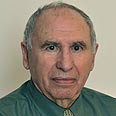





The Yad Vashem Holocaust Memorial Museum will be holding its annual service marking Holocaust Remembrance Day on Monday at 8 pm.
On Sunday, the museum released the names of the seven Holocaust survivors chosen to light the traditional torches during the ceremony. Six torches will be lit, in memory of the six million Jews murdered in the Holocaust.
All of those chosen survived the Holocaust as children and lost their entire family to the atrocities of the Nazis. After coming to Israel, all seven have become productive members of Israeli society, often dedicating their time to educational and philanthropic endeavors meant to aid Holocaust survivors.
The torch lighters
Yehudit Barnea and Leah Huber, originally from Transylvania, Romania, were sent to Auschwitz in 1944 with their mother and other members of their family. Being identical twins, they were subjected to Dr. Josef Mengele notorious experiments. The two managed to survive numerous "selections" until the camp was liberated. They came to Israel in 1960. Barnea has three children and five grandchildren. Huber has two children and seven grandchildren.
Solomon Feigerson was born in 1930 in Latvia. In 1942, his parents and siblings were murdered by the Nazis. In 1943 he was captured and sent to the Kaiserwald forces labor forced camp and in 1945 he was sent, along with 500 other prisoners, to a Baltic Sea voyage, on which he was meant to find his death. He survived and in 1945 was found by a British soldier, frail and ill. After the war he studied engineering in Riga. In 1970, after several years of fighting the Latvian authorities, he was able to come to Israel. Feigerson is married and has one son.
Shimon Grunhaus and his families were placed in a Nazi detention camp in Belarus in 1941. In 1943, he survived death by falling under his father's body, as he was shot – along with dozens of their town Jews, by a Nazi death squad. Shimon and his mother were able to escape, hiding in the nearby forest until they were able to join the local Partisan group. In 1960 the two came to Israel. Grunhaus married and is the father of four and the grandfather of three.
Esther Devorah Reizel-Mosel was four when her parents trusted her life to a neighboring Christian family in their now Nazi-occupied Dutch town. The neighbors eventually changed their minds and she was returned to her portents, who were in Amsterdam. In 1944 the family was transported to Bergen-Belsen and in 1945 she, along with 2,500 other prisoners, were put on a train, "Bound for a better place." The train was shelled by the Soviet army and bombed by British war planes, but she managed to survive. In 1950, with her aunt and uncle, she came to Israel. Reizel-Mosel had three daughters and five grandchildren.
Leah Paz was born in Poland. In 1942, at the age of 12, she was transported to the Belzec death camp with her mother and grandmother. Rumors of the nearing end caused her mother to sneak Leah out of the train via a narrow gap between the cars. She wondered the forest for days until she was able to reunite with her uncle and grandfather. Her uncle then acquired forged documents, created a new identity for her and placed her with a non-Jewish family. They were later deemed Righteous Among the Nations by Yad Vashem. After the war, she immigrated to Israel, married and had two children. She is also the grandmother of six.
Miriam Schuster, her parents and five brothers were transported from their Serbian home to the Bajnica concentration camp in 1941. In 1944 the Soviets liberated the camp, finding only a few hundreds of the 10,000 Jews living in it alive. She came to Israel in early 1948, married and is the mother of three and the grandmother of eight.















